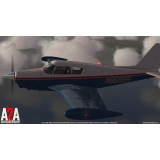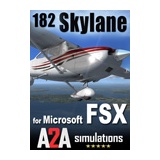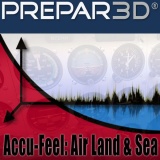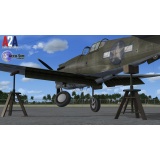Accu-Sim Expansion Pack
Accu-Sim is A2A Simulations' growing flight simulation engine, which is now connectable to other host simulations. In this case, we have attached our Accu-Sim Spitfire MkI and MkII to Microsoft Flight Simulator X to provide the maximum amount of realism and immersion possible.
What is the philosophy behind Accu-Sim?
Pilots will tell you that no two aircraft are the same. Even taking the same aircraft up from the same airport to the same location will result in a different experience. For example, you may notice one day your engine is running a bit hotter than usual and you might just open your cowl flaps a bit more and be on your way, or maybe this is a sign of something more serious developing under the hood. Regardless, you expect these things to occur in a simulation just as they do in life. This is Accu-Sim, where no two flights are ever the same.
Realism does not mean having a difficult time with your flying. While Accu-Sim is created by pilots, it is built for everyone. This means everything from having a professional crew there to help you manage the systems, to an intuitive layout, or just the ability to turn the system on or off with a single switch. However, if Accu-Sim is enabled and the needles are in the red, there will be consequences. It is no longer just an aircraft, it's a simulation.
Actions Lead to Consequences
Your A2A Simulations Spitfire is a complete aircraft with full system modeling. However, flying an aircraft as large and complex as the A2A Spitfire requires constant attention to the systems. The infinite changing conditions around you and your aircraft have impact on these systems. As systems operate both inside and outside their limitations, they behave differently. For example, the temperature of the air that enters your carburetor has a direct impact on the power your engine can produce. Pushing an engine too hard may produce just slight damage that you, as a pilot, may see as it just not running quite as good as it was on a previous flight. You may run an engine so hot, that it catches fire. However, it may not catch fire; it may just quit, or may not run smoothly. This is Accu-Sim – it’s both the realism of all of these systems working in harmony, and all the subtle, and sometimes not so subtle, unpredictability of it all. The end result is when flying in an Accu-Sim powered aircraft, it just feels real enough that you can almost smell the avgas.
Your Aircraft Talks
We have gone to great lengths to bring the internal physics of the airframe, engine, and systems to life. Now, when the engine coughs, you can hear it and see a puff of smoke. If you push the engine too hard, you can also hear signs that this is happening. Just like an actual pilot, you will get to know the sounds of your aircraft, from the tires scrubbing on landing to the stresses of the airframe to the canopy that is cracked opened.
Be Prepared – Stay Out of Trouble
The key to successfully operating your Spitfire, or any high performance aircraft for that matter, is to stay ahead of the curve and on top of things. Aircraft are not like automobiles, in the sense that weight plays a key role in the creation of every component. So, almost every system on your aircraft is created to be just strong enough to give you, the pilot, enough margin of error to operate safely, but these margins are smaller than those you find in an automobile. So, piloting an aircraft requires both precision and respect of the machine you are managing.
It is important that you always keep an eye on your oil pressure and engine temperature gauges. On cold engine starts, the oil is thick and until it reaches a proper operating temperature, this thick oil results in much higher than normal oil temperatures. In extreme cold, once the engine is started, watch that oil pressure gauge and idle the engine as low as possible, keeping the oil pressure under 120psi.
The oil and coolant temperature gauges are critical throughout your flight. Idling too long on the pavement will overheat this Spitfire because it's cooling radiator is inadequate. Plan to be off the ground in under ten minutes. Don't let your engine exceed 100 degrees Celsius before your takeoff roll.
Once airborne, you will want to avoid steep climbs, especially in hot weather, to keep good airflow to your radiator. You will also want to keep your radiator opened at all times during flight, adjusting it to maintain temperatures around 100 degrees if possible, never more than 120 degrees. High engine power increases both water and oil temperatures, but oil is also heated up quite a bit by engine friction (RPM). So if you are running hot oil temperatures, you may wish to also decrease your engine RPM.
Accu-Sim for the Wings of POWER 3 Spitfire FEATURES:
-
Introducing a true propeller simulation
-
Feel the exhilaration of flying an Accu-Sim-powered Supermarine Spitfire.
-
Rolls Royce Merlin V-12 liquid cooled Mk III and higher output Mk XII engine built to manufacturer's specifications.
-
Install a Weybridge two-bladed fixed-pitch wooden, De Havilland three-bladed two-speed variable, or Rotol constant speed propeller in the maintenance hangar.
-
Both electric and explosive cartridge starters modeled.
-
Immersive in-cockpit, physics-driven sound environment from A2A engineered Spitfire recordings.
-
Complete maintenance hangar including landing gear, internal systems and detailed engine tests including compression checks.
-
Understand how a high-performance aircraft behaves and see how well you can cope with all of the unexpected things that can happen. No two flights are ever the same.
-
Piston combustion engine modeling. Air comes in, it mixes with fuel and ignites, parts move, heat up, and all work in harmony to produce the wonderful sound of a V-12, liquid-cooled racing engine. Now the gauges look beneath the skin of your aircraft and show you what Accu-Sim is all about.
-
Airflow, density and it's temperature not only affect the way your aircraft flies, but how the internal systems operate.
-
Real-world conditions affect system conditions, including engine temperatures. Manage temperatures with a radiator flap and proper flying techniques.
-
Spark plugs can clog and eventually foul if the engine is allowed to idle too low for too long. Throttling up an engine with oil-soaked spark plugs can help clear them out and smoke.
-
Overheating can cause scoring of cylinder head walls which could ultimately lead to failure if warnings are ignored and overly abused.
-
The Spitfire has a small radiator and must get airborne in under ten minutes or it will overheat. Once airborne, it owns the sky.
-
Engine, airframe, cockpit panel and individual gauges tremble from the power of a high-performance combustion engine.
-
Authentic component drag. Dropping your gear will pull your aircraft realistically as the landing gear is deployed along with cooling flaps, ordnance and even opening the canopy. Drop your gear, deploy your flaps, or just try a dive, and listen to your airframe.
-
System failures, including flaps that can independently jam or break based on the actual forces put upon them. If you deploy your flaps at too high a speed, you could find yourself in a very dangerous situation.
-
Total audible cockpit made with recordings from the actual aircraft. Before you fly, enjoy clicking everything.
-
Primer system modeled. Accu-Sim monitors the amount of fuel injected and it's effectiveness to start the engine. Cold mornings require as many as 12 strokes and warm starts may only need a single shot.
-
Authentic battery. The battery capacity is based on temperature. The major draw comes from engine starting.
-
Oil pressure system is affected by oil viscosity (oil thickness). Oil viscosity is affected by oil temp and oil dilution level. Now when you start the engine, you need to be careful and not raise RPM too much until oil temp is high enough to give proper oil pressure. If you raise RPM too high on a cold engine, especially very cold, oil pressure can raise to over 150 psi. Oil pump failure can result. Extended inverted flight (negative g) can uncover the oil sump and reduce oil pressure. Do not fly in a negative g situation for more than 5 seconds.
-
Oxygen starvation (hypoxia) is modeled. Just take off and climb without oxygen to see.





